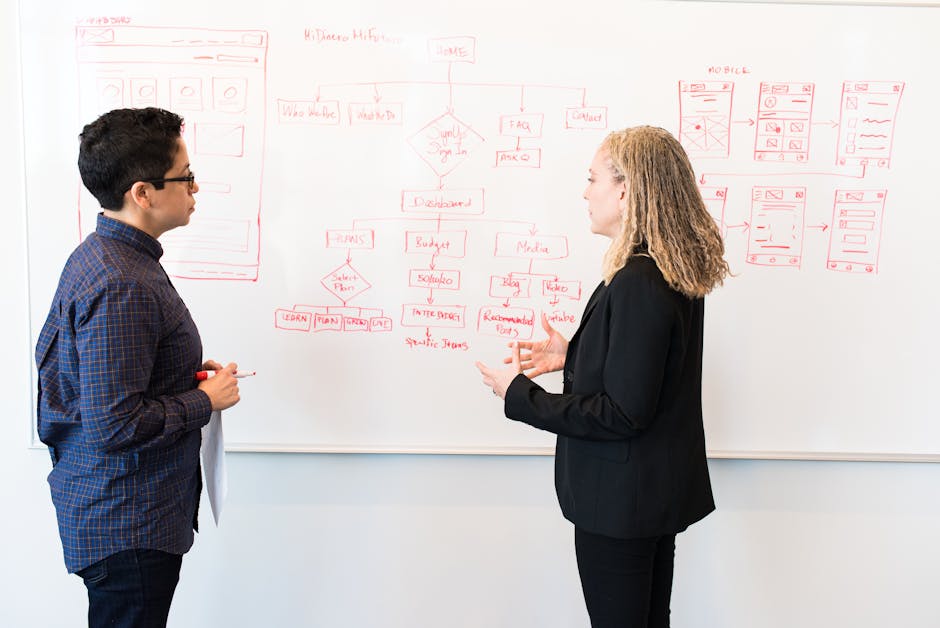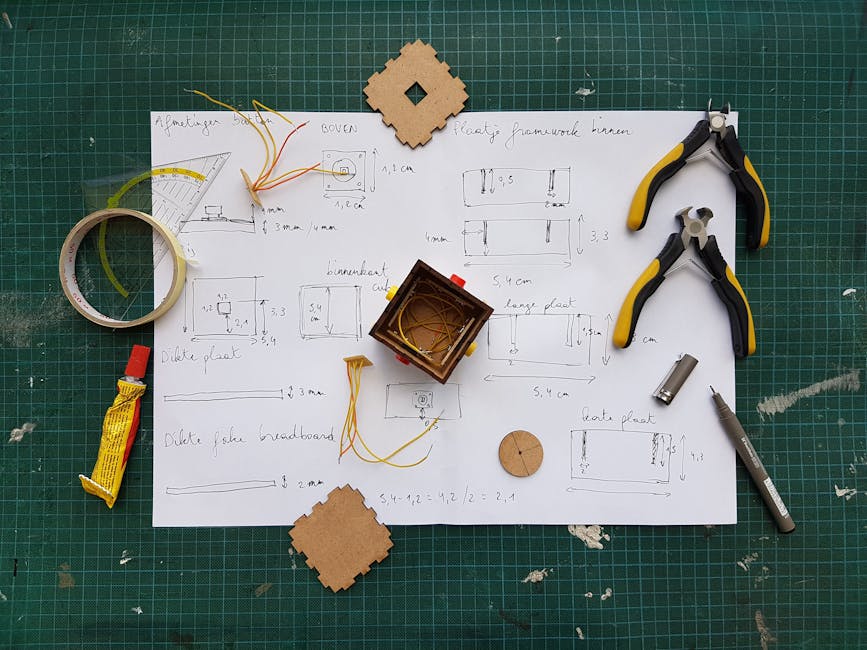Overview of the UX Design Process in Custom Software Development
Begin an engaging journey into the world of UX design in custom software development. Initiate with thorough user research, revealing insights through personas and focus groups. Immerse yourself in useability testing to uncover hidden gems and enhance user experience. Craft a user-centric information architecture to pave the way for seamless navigation. Create wireframes to bring ideas to life, focussing on layout and flow. Prototype swiftly to refine designs based on user interactions. Delve into useability testing to uncover hidden gems and enhance user experience. Through continuous testing and iterative improvements, sculpt a software masterpiece that resonates with users. Each phase is a brushstroke in the art of creating exceptional user experiences.
Key Takeaways
- User research establishes user needs and behaviours.
- Information architecture organises content for clear navigation.
- Wireframing visualises layout and user flow.
- Prototyping allows rapid feedback and iteration.
- Useability testing refines design based on user interactions.
User Research

Begin your UX design journey by delving into the foundational stage of user research, where you gather valuable insights to shape the user experience. User personas, the fictional characters representing your target audience, are key in understanding user needs and behaviours. Imagine Becky, the busy mum who values efficiency, or Alex, the tech-savvy student looking for innovation. These personas help you tailor your design to meet specific user requirements.
Focus groups offer a lively setting to gather opinions from a diverse group of individuals. Engage in meaningful discussions, observe reactions, and uncover preferences.
Ethnographic research takes you into the users’ natural environment to understand their interactions with technology firsthand. Watch how they navigate daily tasks and identify pain points that your design could alleviate.
User surveys provide quantitative data to complement qualitative insights. Craft questions that uncover preferences, frustrations, and expectations.
Information Architecture

Crafting a well-structured information architecture is akin to building a roadmap that guides users seamlessly through your digital landscape. Just like planning the layout of a city to guaranty smooth traffic flow, in the digital domain, you need to design a clear navigation structure and user flow.
Think of your content hierarchy as the different districts within your city – each with its unique characteristics and purpose. Establishing a solid labelling system is vital; it’s like having clear road signs that direct users to their desired destinations efficiently.
When creating your information architecture, consider how users will move through your software. Imagine them as explorers wandering through your digital world – make sure they can easily find what they’re looking for without getting lost. By organising your content effectively and providing intuitive navigation, you can enhance the user experience and make their journey enjoyable.
Wireframing

Begin the adventure of wireframing, an essential step in creating a visual blueprint for your digital masterpiece. When diving into the world of wireframing, remember these key points:
-
Visual Hierarchy: Establishing a clear visual hierarchy guarantees that users can easily navigate through your digital creation. By prioritising content based on importance, you guide users seamlessly through their journey.
-
User Flow: Mapping out the user flow within your wireframes helps anticipate how users will interact with your software. Understanding this flow allows for a more intuitive and user-friendly design.
-
Layout Design: Crafting a well-thought-out layout design in your wireframes sets the foundation for an aesthetically pleasing and functional interface. This stage is where you bring together elements like navigation, content placement, and interaction points.
Wireframing is the stage where ideas start to take shape without the distraction of colours and images. It’s like sketching the outline of a painting before adding the vibrant colours – a pivotal step in the journey towards a remarkable user experience.
Prototyping

Let’s talk about the exciting world of prototyping!
Get ready to reap the benefits of rapid prototyping, allowing you to quickly validate ideas and gather feedback.
Engage in user interaction testing to guaranty your design resonates with your audience and embrace iterative design improvements for a polished final product.
Rapid Prototyping Benefits
Explore how rapid prototyping can greatly enhance your design process by streamlining feedback and iteration cycles, ultimately leading to more user-centred solutions. Rapid prototyping is a pivotal tool in the world of design thinking, allowing you to quickly materialise your concepts and put them to the test.
Here are three key benefits of integrating rapid prototyping into your workflow:
-
Visual Design Validation: With rapid prototyping, you can visualise your ideas in a tangible form, enabling you to assess the visual design elements early on in the process. This helps in refining aesthetics and ensuring a cohesive visual language throughout the project.
-
User Feedback Integration: Rapid prototypes facilitate the gathering of valuable user feedback at an early stage, allowing you to make informed design decisions based on real user interactions. This iterative process ensures that your final product resonates with your target audience.
-
Efficient Iteration Loops: By accelerating the feedback loop, rapid prototyping enables you to quickly iterate on your design, making improvements and adjustments swiftly. This agility in the design process leads to more refined and user-centric solutions.
User Interaction Testing
Enhancing your design process with user interaction testing through prototyping allows you to refine and validate your ideas based on real user experiences. User feedback becomes your trusty compass, guiding you through the maze of design tweaks.
As you navigate the world of useability improvements, each click, swipe, and scroll reveals new insights that help sculpt your creation into a masterpiece of interaction enhancements.
Prototyping serves as a playground where your ideas can frolic freely, interacting with users in a controlled yet realistic environment. It’s like creating a mini virtual world where user feedback reigns supreme, shaping the destiny of your design.
Through this process, you can identify pain points, uncover hidden gems, and fine-tune the user experience to perfection.
Iterative Design Improvements
Begin a journey of iterative design improvements through prototyping, where each iteration brings you closer to the perfect user experience.
-
Design Iteration: Embrace the beauty of imperfection as you iterate on your designs based on user feedback. Remember, Rome wasn’t built in a day, and neither is a flawless user interface.
-
Continuous Refinement: Much like a fine wine, your design evolves over time. Constantly refine and enhance your prototype to guaranty it alines perfectly with user needs and expectations.
-
Design Evolution: Watch in awe as your design transforms from a mere concept to a fully-fledged, user-centric masterpiece. Let the evolution of your prototype be guided by the valuable insights gained from user feedback.
With each iteration, you’re not just refining your design; you’re sculpting it into a work of art.
Embrace the process of prototyping, for it’s the crucible in which great user experiences are forged.
Useability Testing

Conducting useability tests is like having a sneak peek into the minds of your users, revealing invaluable insights that can shape the success of your UX design.
User feedback is a goldmine waiting to be discovered, offering direct insight into how real users interact with your software. By observing users moving through your product, you can identify pain points, areas of confusion, and features that delight.
Useability metrics, such as task completion rates and time on task, provide quantifiable data to measure the effectiveness of your design.
Through useability testing, you can uncover hidden gems and rough edges that may have gone unnoticed during the design phase. It’s like being a detective, piecing together clues to create a seamless user experience.
Embrace the feedback, whether it’s a pat on the back or a reality cheque. Remember, it’s all about refining and improving your design to meet the needs of your users.
Iterative Design

Let’s discuss Iterative Design – the magical process of continuous improvement in UX design.
Imagine this: you release your creation into the wild, gather feedback, refine based on user insights, then release a better version.
It’s like a never-ending loop of making things awesome, one user test at a time.
Continuous User Testing
Begin a journey of refinement by consistently engaging in user testing throughout the iterative design process, ensuring a user-centric approach to your UX design. Embracing continuous user testing not only enhances user experience but also streamlines the development cycle.
Here are three essential tips to guide you through this crucial phase:
-
Listen actively: Pay close attention to user feedback during each testing phase. Users hold the key to valuable insights that can lead to significant product enhancement. Don’t just hear them; truly listen to understand their needs and preferences.
-
Iterate and adapt: Use the feedback gathered to iterate on your design. Make necessary adjustments based on user responses to create a more user-friendly interface. Embracing flexibility in your development cycle allows for continuous improvement.
-
Test early, test often: Incorporate user testing at various stages of development, from wireframes to prototypes. By testing early and frequently, you can identify issues sooner and make informed decisions that positively impact the overall user experience. Remember, the more you test, the more refined your final product will be.
Refine Based on Feedback
To refine your design based on feedback is akin to sculpting a masterpiece, chiselling away imperfections to reveal a user-centric gem. User feedback is your chisel, guiding you towards crafting a product that resonates with your audience. Embrace this iterative process of design refinement; it’s where the magic truly happens.
| User Feedback | Design Refinement |
|---|---|
| Identify pain points | Implement smoother workflows |
| Highlight user preferences | Adjust layout for better useability |
| Address feature requests | Enhance visual appeal |
User feedback provides the compass to navigate the turbulent seas of design. It’s like having a co-pilot guiding you through the foggy domains of uncertainty. By refining your design based on feedback, you are not just polishing the surface; you are delving deeper, reshaping the core to meet the needs of your users. So, listen keenly, adapt thoughtfully, and watch as your design transforms into a user-centred marvel.
Iterative Improvement Cycle
As you commence on the journey of the iterative improvement cycle, envision your design evolving like a sculptor moulding clay, each iteration bringing it closer to perfection.
Embracing this iterative approach in custom software development allows for continuous refinement and enhancement of your design based on valuable design feedback.
Here’s how to make the most of the iterative improvement cycle:
-
Embrace Feedback: Seek feedback from users, stakeholders, and team members to gain different perspectives on your design. Constructive criticism is like a compass guiding you towards design improvements.
-
Iterate Regularly: Set short iteration cycles to make incremental changes. Each iteration builds upon the last, gradually shaping your design into a user-friendly masterpiece.
-
Test and Learn: Implement user testing at each iteration to validate design decisions. Learn from user interactions and adapt your design accordingly to make sure it meets user needs effectively.
Conclusion
To wrap up, the UX design process in custom software development plays a vital role in creating an exceptional user experience.
Did you know that 88% of online consumers are less likely to return to a site after a bad experience?
By conducting thorough user research, creating intuitive information architecture, and continuously testing and iterating designs, you can guaranty that your custom software will delight users and keep them coming back for more.
So, remember – happy users, happy software!
Contact us to discuss our services now!
